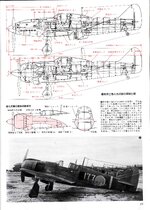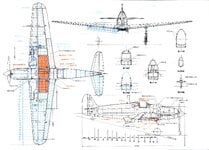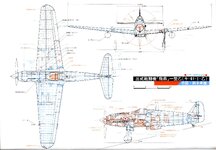Ki-61-I Ko / Otsu / Hei
Empty Weight: 2380kg
Loaded Weight: 3130kg
Wing Area: 20m2
Engine: Ha-40
Take Off: 1160hp (WEP)
1030hp at SL / 1085hp at 4200m
-
Max Speed: (Military Power) [Mannifold Pressure]
Sea Level: 471kph [39Hg]
1000m: 496kph [39Hg]
2000m: 520kph [39Hg]
3000m: 545kph [39Hg]
4000m: 569kph [39Hg]
4760m: 588kph [39Hg]
5000m: 589kph [38Hg]
6000m: 591kph [34Hg]
7000m: 589kph [30Hg]
8000m: 580kph [26Hg]
9000m: 561kph [23Hg]
10000m: 523kph [20Hg]
-
Rate of Climb: (Military Power)
Time to 5000m: 5:30
Time to 8000m: 10:48
-
Stall Speed: (No Flaps, 1000m, 3130kg Weight)
150km/h IAS
-
Armament:
Ko:
2x 7.7mm Type 89
2x 12.7mm Ho-103
-
Otsu:
4x 12.7mm Ho-103
-
Hei:
2x 12.7mm Ho-103
2x 20mm MG-151
-
Sustained Turn Time: (WEP, Sea Level)
16 Seconds
—————————————
Ki-61-I Tei
Empty Weight: 2630kg
Loaded Weight: 3470kg
Wing Area: 20m2
Engine: Ha-40
Take Off: 1160hp (WEP)
1030hp at SL / 1085hp at 4200m
-
Max Speed: (Military Power)
Sea Level: 462kph
5000m: 580kph
-
Rate of Climb: (Military Power)
Time to 5000m: 7:00
-
Stall Speed: (No Flaps, 1000m, 3470kg Weight)
158km/h IAS
-
Armament:
2x 12.7mm Ho-103
2x 20mm Ho-5
-
Sustained Turn Time: (WEP, Sea Level)
18 Seconds
—————————————
Ki-61-II KAI Ko / Otsu:
Empty Weight: 2855kg
Loaded Weight: 3825kg
Wing Area: 20m2
Engine: Ha-140
Take Off: 1500hp (WEP)
1350hp at SL / 1250hp at 5700m
-
Max Speed: (Military Power / WEP)
Sea Level: 525kph / 544kph
3000m: 580kph / ???
5000m: 598kph / ??? (Probably 625-632kph)
6000m: 610kph / ???
10,000m: 544kph / 544kph
-
Rate of Climb: (Military Power / WEP)
Time to 5000m: 6:30 / 5:40
-
Stall Speed: (No Flaps, 1000m, 3825kg Weight)
166km/h IAS
-
Armament:
2x 12.7mm Ho-103
2x 20mm Ho-5
-
Sustained Turn Time: (WEP, Sea Level)
19 Seconds
——————————————
Ki-100-I Ko / Otsu:
Empty Weight: 2525kg
Loaded Weight: 3495kg
Wing Area: 20m2
Engine: Ha-112-II
Take Off: 1500hp (WEP)
1260hp at SL / 1350hp at 2000m / 1250hp at 6000m
-
Max Speed: (Military Power / WEP)
Sea Level: 485kph / 514kph
1000m: 510kph / 541kph
2000m: 538kph / 570kph
3000m: 542kph / 574kph
4000m: 545kph / 578kph
5000m: 567kph / 601kph
6000m: 580kph / 585kph
-
Rate of Climb: (Military Power)
Time to 1000m: 1:06
Time to 2000m: 2:10
Time to 3000m: 3:22
Time to 4000m: 4:42
Time to 5000m: 6:00 (5:00 WEP)
-
Stall Speed: (No Flaps, 1000m, 3495kg Weight)
158km/h IAS
-
Armament:
2x 12.7mm Ho-103
2x 20mm Ho-5
-
Turn Time:
17 Seconds
——————————————
Ki-100-II:
Empty Weight: 2700kg
Loaded Weight: 3670kg
Wing Area: 20m2
Engine: Ha-112-II Ru
Take Off: 1500hp (WEP)
1260hp at SL / 1325hp at 2000m
-
Max Speed: (Military Power / WEP)
Sea Level: 479kph / 508kph
1000m: 500kph / 531kph
2000m: 520kph / 553kph
3000m: 538kph / 572kph
4000m: 551kph / 584kph
5000m: 563kph / 594kph
6000m: 572kph / 603kph
7000m: 580kph / 610kph
8000m: 585kph / 614kph
9000m: 580kph / 595kph
10000m: 565kph / 571kph
-
Rate of Climb: (Military Power)
Time to 1000m: 1:16
Time to 2000m: 2:23
Time to 3000m: 3:51
Time to 4000m: 5:13
Time to 5000m: 6:40 (5:12 WEP)
Time to 8000m: 11:30
Time to 10000m: 18:00
-
Stall Speed: (No Flaps, 1000m, 3670kg Weight)
163km/h IAS
-
Armament:
2x 12.7mm Ho-103
2x 20mm Ho-5
-
Turn Time:
18.5 Seconds
Empty Weight: 2380kg
Loaded Weight: 3130kg
Wing Area: 20m2
Engine: Ha-40
Take Off: 1160hp (WEP)
1030hp at SL / 1085hp at 4200m
-
Max Speed: (Military Power) [Mannifold Pressure]
Sea Level: 471kph [39Hg]
1000m: 496kph [39Hg]
2000m: 520kph [39Hg]
3000m: 545kph [39Hg]
4000m: 569kph [39Hg]
4760m: 588kph [39Hg]
5000m: 589kph [38Hg]
6000m: 591kph [34Hg]
7000m: 589kph [30Hg]
8000m: 580kph [26Hg]
9000m: 561kph [23Hg]
10000m: 523kph [20Hg]
-
Rate of Climb: (Military Power)
Time to 5000m: 5:30
Time to 8000m: 10:48
-
Stall Speed: (No Flaps, 1000m, 3130kg Weight)
150km/h IAS
-
Armament:
Ko:
2x 7.7mm Type 89
2x 12.7mm Ho-103
-
Otsu:
4x 12.7mm Ho-103
-
Hei:
2x 12.7mm Ho-103
2x 20mm MG-151
-
Sustained Turn Time: (WEP, Sea Level)
16 Seconds
—————————————
Ki-61-I Tei
Empty Weight: 2630kg
Loaded Weight: 3470kg
Wing Area: 20m2
Engine: Ha-40
Take Off: 1160hp (WEP)
1030hp at SL / 1085hp at 4200m
-
Max Speed: (Military Power)
Sea Level: 462kph
5000m: 580kph
-
Rate of Climb: (Military Power)
Time to 5000m: 7:00
-
Stall Speed: (No Flaps, 1000m, 3470kg Weight)
158km/h IAS
-
Armament:
2x 12.7mm Ho-103
2x 20mm Ho-5
-
Sustained Turn Time: (WEP, Sea Level)
18 Seconds
—————————————
Ki-61-II KAI Ko / Otsu:
Empty Weight: 2855kg
Loaded Weight: 3825kg
Wing Area: 20m2
Engine: Ha-140
Take Off: 1500hp (WEP)
1350hp at SL / 1250hp at 5700m
-
Max Speed: (Military Power / WEP)
Sea Level: 525kph / 544kph
3000m: 580kph / ???
5000m: 598kph / ??? (Probably 625-632kph)
6000m: 610kph / ???
10,000m: 544kph / 544kph
-
Rate of Climb: (Military Power / WEP)
Time to 5000m: 6:30 / 5:40
-
Stall Speed: (No Flaps, 1000m, 3825kg Weight)
166km/h IAS
-
Armament:
2x 12.7mm Ho-103
2x 20mm Ho-5
-
Sustained Turn Time: (WEP, Sea Level)
19 Seconds
——————————————
Ki-100-I Ko / Otsu:
Empty Weight: 2525kg
Loaded Weight: 3495kg
Wing Area: 20m2
Engine: Ha-112-II
Take Off: 1500hp (WEP)
1260hp at SL / 1350hp at 2000m / 1250hp at 6000m
-
Max Speed: (Military Power / WEP)
Sea Level: 485kph / 514kph
1000m: 510kph / 541kph
2000m: 538kph / 570kph
3000m: 542kph / 574kph
4000m: 545kph / 578kph
5000m: 567kph / 601kph
6000m: 580kph / 585kph
-
Rate of Climb: (Military Power)
Time to 1000m: 1:06
Time to 2000m: 2:10
Time to 3000m: 3:22
Time to 4000m: 4:42
Time to 5000m: 6:00 (5:00 WEP)
-
Stall Speed: (No Flaps, 1000m, 3495kg Weight)
158km/h IAS
-
Armament:
2x 12.7mm Ho-103
2x 20mm Ho-5
-
Turn Time:
17 Seconds
——————————————
Ki-100-II:
Empty Weight: 2700kg
Loaded Weight: 3670kg
Wing Area: 20m2
Engine: Ha-112-II Ru
Take Off: 1500hp (WEP)
1260hp at SL / 1325hp at 2000m
-
Max Speed: (Military Power / WEP)
Sea Level: 479kph / 508kph
1000m: 500kph / 531kph
2000m: 520kph / 553kph
3000m: 538kph / 572kph
4000m: 551kph / 584kph
5000m: 563kph / 594kph
6000m: 572kph / 603kph
7000m: 580kph / 610kph
8000m: 585kph / 614kph
9000m: 580kph / 595kph
10000m: 565kph / 571kph
-
Rate of Climb: (Military Power)
Time to 1000m: 1:16
Time to 2000m: 2:23
Time to 3000m: 3:51
Time to 4000m: 5:13
Time to 5000m: 6:40 (5:12 WEP)
Time to 8000m: 11:30
Time to 10000m: 18:00
-
Stall Speed: (No Flaps, 1000m, 3670kg Weight)
163km/h IAS
-
Armament:
2x 12.7mm Ho-103
2x 20mm Ho-5
-
Turn Time:
18.5 Seconds
Last edited:



